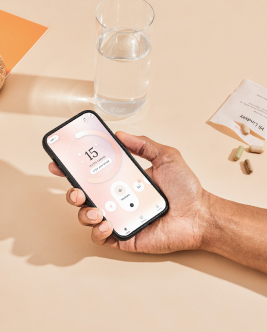nutrition
What Foods to Eat During Your Period to Reduce Symptoms
On This Page

Nutrition plays a huge role in menstrual cycle health. Certain foods can help reduce period symptoms and balance your hormones for future cycles.
Nutrition plays a huge role in the health of the menstrual cycle. From supporting hormone balance throughout the month to affecting how you feel on your period, foods can have a big impact.
How does your menstrual cycle affect your body?
The menstrual cycle consists of four phases: menstrual phase (your period), follicular phase, ovulatory phase, and luteal phase. During menstruation (bleeding), the biochemical changes that happen to help shed the uterine lining can cause PMS related symptoms like cramps, bloating, headaches, and fatigue. Increasing estrogen levels can cause breast tenderness while progesterone increases can lead to mood changes and fatigue. Basal body temperature generally increases throughout the cycle. These are just a few examples of the many changes that occur during the menstrual cycle.
Because of the rhythmic nature of the menstrual cycle, it may be best to adjust lifestyle to complement the phase of the cycle. An example of this is adjusting exercise type and intensity throughout the menstrual cycle. During the menstrual phase, gentle exercise like yoga or walking may feel best, whereas higher intensity exercises like running or kickboxing may feel best around ovulation when energy is likely higher. Not everyone will have the same experience during the menstrual cycle or have the same needs, to listen to your body.
How do your nutritional needs change during your menstrual cycle
As you can see, there’s a lot of change in the body throughout the menstrual cycle. These changes may lead you to consider changing nutrition needs to support the processes or reduce symptoms.
Nutrients to hone in on during your menstrual cycle
Calcium
Estrogen can increase calcium absorption and support good levels of calcium in the bones. In fact, calcium levels in the blood are generally highest during the follicular phase when estrogen levels are peaking. Near the end of the luteal phase leading up to the next menstrual period, calcium levels may take a dip which can result in premenstrual mood symptoms (PMS), headaches and cramps. Eating calcium-rich foods such as dairy products and dark leafy greens may help. Another option to support healthy calcium levels would be Care/of Calcium Plus supplement especially for those who are lactose intolerant, vegan, or those with absorption issues.
Carbohydrates
Carbohydrates can be a helpful source of energy during times of the menstrual cycle when energy levels may be lower, especially during times of lower estrogen. Carbs can also help boost serotonin levels, which are also impacted by estrogen levels.
Some may find that consuming some complex carbohydrates with a low glycemic index can be helpful to boost mood and energy and allay cravings during the time leading up to and during their period.
Iron
Menstrual bleeding can lead to iron loss. Eating iron-rich foods such as red meat, poultry, fish, lentils, and dark leafy greens can help replenish iron levels and reduce fatigue and weakness. If you suspect your iron levels are low, ask your doctor to measure your levels. Iron should only be supplemented for those who do not get enough from their diet. Care/of Iron is carefully formulated with a chelated form of iron and vitamin C to ensure optimal absorption.
Fiber
Gastrointestinal changes can occur throughout the menstrual cycle, which can alter bowel movement frequency. Hormonal fluctuations can lead to slower gut motility and sometimes constipation in the days leading up to the period. During the period, however, looser stools may be more common. This is thought to be a result of the biochemical changes that help shed the uterine lining, resulting in increased intestinal motility and contractions. The exact reason behind how this all happens is still being investigated.
Eating foods with soluble fiber such as fruit, oats, and ground flaxseeds during the period may help to thicken the stools. Care/of has a powdered combination of chia, flax seeds, and pea fiber called “The Fiber Starters” as a convenient way to boost your fiber intake, support your digestive health, and help add bulk to your stools. One scoop contains 4 grams of fiber and it tastes great when added to yogurt, oatmeal, or protein shakes.
Magnesium
Magnesium can help promote period comfort through managing prostaglandins, relaxing the uterus, and reducing fluid retention. Although these studies looked at specific types of magnesium in supplement form (oxide and Mg 5-longoral, Artesan GmbH), you can proactively increase intake of magnesium-rich foods such as pumpkin seeds, which contain a whopping 156 mg magnesium per one ounce, as well as chia seeds, almonds, cashews, and spinach.
Antioxidants
Oxidative stress is a normal part of the daily bodily functions but needs to be kept in check by antioxidants. Antioxidants may help balance levels of increased oxidative stress during the period, which may help promote period comfort and manage other uncomfortable PMS related symptoms. These healthy compounds can also support hormone balance by protecting the endocrine system from oxidative stress and supporting the liver’s ability to metabolize hormones. This pilot study shows initial promise for antioxidants also supporting egg health and fertility.
Eating fruits and vegetables such as berries, citrus fruits, leafy greens, and cruciferous vegetables can help provide a variety of antioxidants.
Vitamin B12
Due to the role of Vitamin B12 in red blood cell production, getting enough of this vitamin is important to replenish blood loss from period bleeds. This vitamin is also required for nerve function, as well as converting food into energy. This vitamin is also important for those who are following plant based diets. Care/of has a high quality B12 supplement called ‘The Energizer’ that includes 3 different forms of vitamin B12 (methylcobalamin, adenosylcobalamin, and hydroxocobalamin) along with acacia to ensure ease of use and absorption in the body. Vitamin B12 is best found in fish, animal meat, fortified nutritional yeast, and some dairy products.
Foods to eat during your period
Most foods have some kind of health benefit for the body regardless of the phase of menstrual cycle you are in. The key is eating a variety of foods to support overall health.
Bananas
Bananas are rich in vitamin B6, which can help support balanced hormones. They are also a good source of tryptophan, the amino acid that is used in the body to make serotonin, which can support a healthy mood. Bananas also provide a good amount of the soluble fiber pectin, which may help support healthy bowel movements throughout the menstrual cycle.
Beetroot
Beetroot, or commonly just called beets, are a good source of antioxidants and folate. They also contain betalains, a compound that can support liver functions like hormone metabolism with its liver protective properties.
Broccoli
Broccoli is high in vitamin C, which is a powerful antioxidant. It also contains a phytochemical compound called sulforaphane, which may help reduce menstrual cramps through managing prostaglandin levels. Broccoli is also a source of diindolylmethane (DIM), which can help promote hormone balance and support estrogen metabolism.
Dark chocolate
Dark chocolate is an excellent source of magnesium, with one ounce of dark chocolate providing about 70 mg of magnesium. It is also rich in antioxidants and iron and provides some tryptophan, the precursor to serotonin which may boost mood. Aim to choose dark chocolate with a higher percentage of cocoa to get the most benefits and less sugar.
Fish and seafood
Seafood overall is rich in minerals, and shellfish in particular are great sources of iron. Seafood also provides zinc, which can help regulate the menstrual cycle. Oysters in particular have the highest amount of zinc among all foods.
Seafood, particularly fatty fish such as salmon, mackerel, and tuna, is a good source of omega-3 fatty acids, which can help manage PMS symptoms and promote menstrual comfort. Omega-3s may also help regulate hormone levels and support fertility.
Eggs
Eggs are an excellent source of highly bioavailable protein, which may help reduce cravings leading up to or during the period. The yolks in particular are an excellent source of choline, vitamins A, D, and B12, iron, and the antioxidant-like mineral selenium. Choline in particular plays vital roles in nervous system function, as well as hormone production and metabolism.
Oatmeal
Oats are a great complex carbohydrate food, which may help boost mood and energy levels. They also provide soluble fiber, which may act as a prebiotic and help reduce bloating and support healthy bowel movements before and during the period. Oats are also a good source of the minerals iron, magnesium, zinc, and selenium, which can all support healthy menstrual cycles.
Citrus fruits
Citrus fruits are excellent sources of the antioxidant vitamin C along with other antioxidant flavonoids that can help manage oxidative stress. Vitamin C helps to absorb the non-heme type iron in plant foods to make it more bioavailable in the body. Incorporating more citrus fruits during or after your period can help replenish iron absorption from non heme food sources like spinach.
Watermelon
Eating watermelon is a tasty way to stay hydrated with its high water and potassium content. In order to maintain a healthy fluid balance, it’s important to stay hydrated during the menstrual cycle – and watermelon can be a big help with that! Watermelon is also rich in antioxidants such as vitamin C and lycopene. It’s also a great source of the amino acid L-citrulline, which can ease menstrual cramps through dilating blood vessels with nitric oxide production. While the white rind is not as sweet, it contains a higher amount of nutrients. "higher amount of nutrients") and can even be roasted like vegetables for a savory snack.
Figs
Figs are a good source of calcium, providing about 104 mg of calcium per eight figs. They can also be a helpful snack to satisfy sweet cravings while being lower in the glycemic index than other sugary foods due to their excellent fiber content.
Plums
Like figs, plums are a healthy sweet snack. Plums are rich in both vitamin C and copper, which both work in managing oxidative stress and are needed for hormone balance. Copper is important in menstrual health because it is needed to make the hemoglobin, the part of red blood cells that contains iron and transports oxygen in the body. Due to their high fiber and antioxidant content, plums may help reduce bloating and cramping related to PMS symptoms.
Lentils and beans
Lentils and beans contain excellent nutrients for menstrual health. They are good sources of fiber, vitamin B6, and other B vitamins, as well as copper, iron, magnesium, potassium, and zinc. They are also a complex carbohydrate, so they can boost steady energy levels.
Ginger
Ginger is a spice that has been shown to promote comfort during the menstrual cycle when taken as 500 mg capsules three times daily in this placebo randomized trial. This effect may stem from the active compound in ginger called gingerol, which has antioxidant properties that can help manage oxidative stress and promote blood flow.
Lean protein
Lean protein sources include chicken, turkey, lean red meat, fish, eggs, Greek yogurt, legumes, and soy. Protein is necessary for growth and repair of body tissues, including the uterus which sheds during the menstrual period and thickens again during the menstrual cycle. Eating adequate amounts of protein can also help support blood sugar balance (already in normal range), which is important for a healthy menstrual cycle. Foods naturally high in protein often contain other important nutrients that can support menstrual health.
Leafy greens
Dark leafy greens, such as spinach, kale, and collard greens, are a great source of many nutrients important for menstrual health, including iron, calcium, magnesium, and vitamin K. They are also rich in antioxidants to help balance oxidative stress in the body.
Peppermint
One of the best uses of peppermint is for relieving menstrual cramps. Peppermint contains compounds that can relax the muscles in the uterus and reduce spasms, which can help alleviate period pain. Peppermint’s cooling effect from the menthol compound can also reduce bloating and gas that are common during menstruation. It can also produce a sense of calm that may help those who experience mood changes around their periods.
Yogurt
Yogurt contains calcium, which may help with PMS symptoms. It also provides probiotic bacteria, which may improve digestive symptoms around the period. Rich in protein, it makes a great energy-boosting snack especially when paired with healthy sources of carbohydrates like fruit.
Foods to avoid during your period
Caffeine
Caffeine may exacerbate symptoms that are already common during menstruation. Its stimulant effect may increase anxiety, irritability, and intestinal cramping. It can also cause dehydration, which can worsen menstrual cramps and headaches. However, caffeine may not affect everyone in the same way. Some may even benefit from its fatigue-reducing and mood-improving properties. Use your best judgment based on your individual needs.
Spicy foods
Spicy foods can irritate the digestive system, causing bloating, cramping, and loose stools, which can be common during the period. Some people may tolerate spicy foods more than others, so it may or may not be something to avoid during the period.
Alcohol
Research is too inconclusive to give overall recommendations on consumption of alcohol and its relation to period health, but choosing to keep alcohol consumption in moderation is still a wise choice. Alcohol is a diuretic, so it can cause dehydration. It can also interfere with metabolism and absorption of certain nutrients that are important for menstrual health, such as vitamin B6 and magnesium. This can lead to deficiencies that can worsen menstrual symptoms. Alcohol can also negatively impact hormone metabolism by the liver, which can lead to hormone imbalances over time.
Sugary foods
Excess sugar and highly processed foods can create temporary unhealthy fluctuations in blood sugar which can worsen symptoms like fatigue, mood swings, and cravings. The American Heart Association recommends limiting sugar intake to 6-9 teaspoons daily to maintain optimal health. Based on findings from this study, high sugar from the diet can also lead to increased prostaglandin levels, which are already increased during menstruation. This can worsen menstrual cramps and contribute to heavier bleeding.
Fried or greasy foods
Fried and greasy foods may exacerbate digestive symptoms for certain people. The type of oil being used can also contribute as different oils have different thermal stable points. They can also lead to excessive amounts of omega-6 fats, which are precursors to prostaglandins and other active compounds that can contribute to cramps and discomfort.
Highly processed foods
Many highly processed foods contain refined carbohydrates and sugars which can lead to temporary, challenging blood sugar fluctuations. These foods are also generally low in nutrients, vitamins, minerals, and antioxidants, which are necessary for healthy menstrual cycles. Eating these foods occasionally does happen however the key is making sure it does not make up the majority of your food intake.
Foods high in fat content
High fat foods, like fried and greasy foods, may worsen digestive symptoms for some. While getting in healthy fats from foods such as avocados, nuts, and salmon may improve period symptoms and support hormone balance throughout the cycle, keeping fats in balance during the period may help promote digestive comfort. Digestive enzymes can also be a way to support the body in breaking down foods and absorb nutrients.
Why hydration is key during your menstrual cycle
During menstruation, the body loses fluids and blood, which can lead to dehydration if fluids are not replenished. Dehydration can worsen many of the symptoms common around the time of the period. Drinking water regularly throughout the period can help, as well as consuming plenty of electrolytes such as potassium and magnesium. Care/of makes convenient electrolyte packets that you can take on the go to help boost your hydration.
What causes period-inducing cravings?
Cravings may tend to increase in the days leading up to the period due to fluctuations in estrogen and progesterone hormones. Changes in hormones and dietary intake can also impact production of neurotransmitters like dopamine and serotonin. Care/of has a supplement made of Shatavari called, “The Rejuvenating Root” which can support PMS related symptoms and another adaptogenic herb made of Ashwagandha called, ‘The Chill Pill’ which can support food cravings.
Should you indulge in your cravings?
Knowing that cravings tend to increase around your period, you can anticipate this by eating adequate protein at every meal and making sure the carbohydrate foods you choose are complex carbs and contain natural sources of fiber. Having a piece of dark chocolate paired with a source of protein like nuts or Greek yogurt can satisfy a sweet craving.
Should you take supplements for your period?
While the foods and tips discussed in this article can have a powerful impact on the health of your menstrual cycle, supplements can further help reduce PMS symptoms by filling in the gaps of nutrients that you don’t get enough of in your diet.
For example, supplementing with magnesium may help fill in the gaps of this commonly inadequately consumed mineral that has so many benefits for period health. Research has shown that combining a magnesium supplement with vitamin B6 can have the most benefits.
Final takeaways
The menstrual cycle is a complex orchestra of hormone changes that requires a host of nutrients throughout the whole process. Focusing on certain foods that contain the necessary nutrients is a great way to support healthy menstrual cycles and periods and reduce uncomfortable symptoms. If you feel that your diet isn’t always cutting it, supplements may help bridge the gaps.



